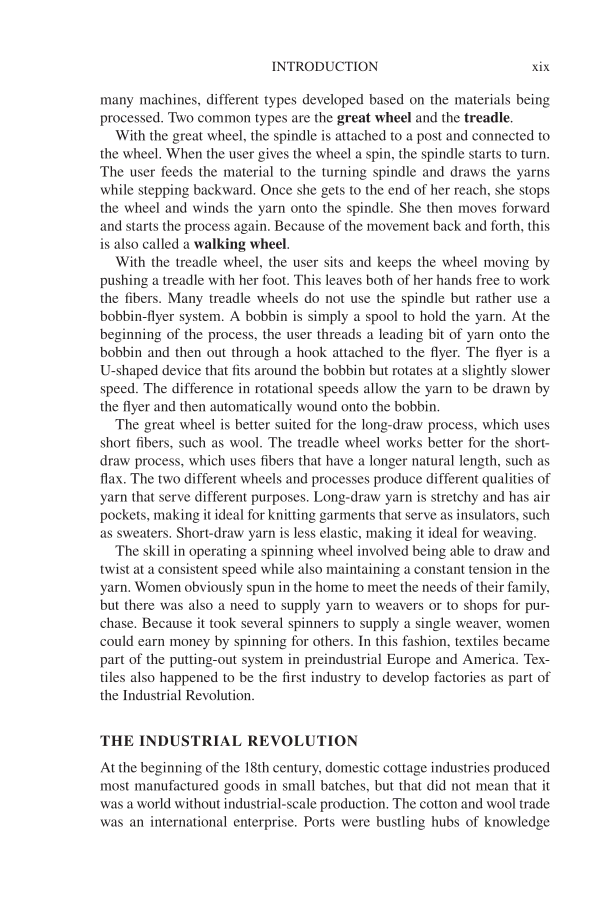INTRODUCTION xix many machines, different types developed based on the materials being processed. Two common types are the great wheel and the treadle. With the great wheel, the spindle is attached to a post and connected to the wheel. When the user gives the wheel a spin, the spindle starts to turn. The user feeds the material to the turning spindle and draws the yarns while stepping backward. Once she gets to the end of her reach, she stops the wheel and winds the yarn onto the spindle. She then moves forward and starts the process again. Because of the movement back and forth, this is also called a walking wheel. With the treadle wheel, the user sits and keeps the wheel moving by pushing a treadle with her foot. This leaves both of her hands free to work the fibers. Many treadle wheels do not use the spindle but rather use a bobbin-flyer system. A bobbin is simply a spool to hold the yarn. At the beginning of the process, the user threads a leading bit of yarn onto the bobbin and then out through a hook attached to the flyer. The flyer is a U-shaped device that fits around the bobbin but rotates at a slightly slower speed. The difference in rotational speeds allow the yarn to be drawn by the flyer and then automatically wound onto the bobbin. The great wheel is better suited for the long-draw process, which uses short fibers, such as wool. The treadle wheel works better for the short- draw process, which uses fibers that have a longer natural length, such as flax. The two different wheels and processes produce different qualities of yarn that serve different purposes. Long-draw yarn is stretchy and has air pockets, making it ideal for knitting garments that serve as insulators, such as sweaters. Short-draw yarn is less elastic, making it ideal for weaving. The skill in operating a spinning wheel involved being able to draw and twist at a consistent speed while also maintaining a constant tension in the yarn. Women obviously spun in the home to meet the needs of their family, but there was also a need to supply yarn to weavers or to shops for pur- chase. Because it took several spinners to supply a single weaver, women could earn money by spinning for others. In this fashion, textiles became part of the putting-out system in preindustrial Europe and America. Tex- tiles also happened to be the first industry to develop factories as part of the Industrial Revolution. THE INDUSTRIAL REVOLUTION At the beginning of the 18th century, domestic cottage industries produced most manufactured goods in small batches, but that did not mean that it was a world without industrial-scale production. The cotton and wool trade was an international enterprise. Ports were bustling hubs of knowledge
Document Details My Account Print multiple pages
Print
You have printed 0 times in the last 24 hours.
Your print count will reset on at .
You may print 0 more time(s) before then.
You may print a maximum of 0 pages at a time.






































































































































































































